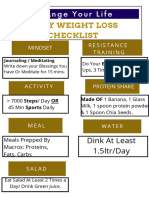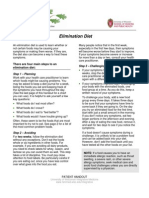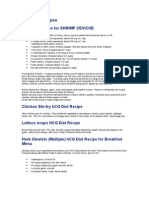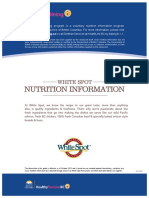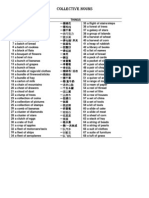Low Sodium Diet
Low Sodium Diet
Uploaded by
David BumphisCopyright:
Available Formats
Low Sodium Diet
Low Sodium Diet
Uploaded by
David BumphisOriginal Description:
Copyright
Available Formats
Share this document
Did you find this document useful?
Is this content inappropriate?
Copyright:
Available Formats
Low Sodium Diet
Low Sodium Diet
Uploaded by
David BumphisCopyright:
Available Formats
Low Sodium Diet
How much sodium can I have?
A 1,500 to 2,000 to milligrams (mg) sodium diet is as part of a healthy eating
plan and helps to maintain a lower blood pressure and prevent swelling from
extra water build up in the body. Your doctor may give you a different sodium
goal based on your health history.
What are some hidden sources of sodium?
Sodium is found in:
Table salt: 1 teaspoon contains 2,300 mg of sodium
Seasonings: onion salt, garlic salt, seasoning salt, seasoning blends
Leavening agents: baking powder (488 mg per teaspoon) and baking soda
(1,259 mg per teaspoon).
Additives and preservatives: brine, di-sodium phosphate, monosodium
glutamate, sodium erythorbate, sodium benzoate, sodium hydrozide,
sodium propionate, sodium sulfite, and sodium nitrite
What are some shopping tips for lowering sodium?
1. Choose fresh or largely unprocessed foods without added salt or sodium-
containing preservatives.
2. Read food labels carefully. Look at the serving size and the sodium
content per serving. Check out the Reference Table on page 4 to learn
more about food labeling definitions.
3. Choose "No Added Salt" or "Low Sodium" canned and frozen foods.
4. Stay away from boxed pasta and rice mixes with seasoning packets since
many of them contain over 600 mg sodium per serving.
UMHS Patient Food and Nutrition Services
-1-
5. Buy fresh meat instead of processed meat. Avoid "basted" or "self-basted"
products which may contain injected broth with salt. Meats marked as
"natural" may also contain injected broth with salt.
6. When buying lunch meat, look for “No Salt Added” or “Low Sodium”
products.
7. Look for low sodium cheeses, such as Swiss, goat or farmers cheese.
8. All fruit is generally low in sodium. Be aware that dried or canned fruits
may be higher in sodium from added sodium benzoate, a preservative.
How else can I cut down on sodium?
Teach your taste buds to want less sodium by searching for new recipes
without added salt. Before you know it, you will like these foods better!
Try using a pinch of Citric Acid, also known as Sour Salt, as a salt
substitute. Citric acid adds a lemony tart taste. Use only a little bit
because it will make food taste sour. You can buy Citric Acid in the
canning aisle of stores.
Use a variety of salt-free herbs and spice blends for flavor during meal
preparation and at the table.
Infuse oils and vinegars with herbs to use as a finishing drizzle over
prepared foods or use them as a marinade. Try warming olive oil and
fresh rosemary in a saucepan over medium heat for one minute. Remove
from the heat and pour over sliced tomatoes. Let stand for 20 minutes.
Top beans, rice or pasta with the marinated tomatoes.
Compare food labels at the grocery store, choosing the lowest in sodium.
Check your local library, bookstore or search the internet for books on
low-sodium cooking. One example is the American Heart Association Low-
Salt Cookbook.
Many low fat and fat-free foods are higher in sodium, so choose wisely
when grocery shopping.
UMHS Patient Food and Nutrition Services
Low Sodium Diet
-2-
Look for “unsalted”, “No Added Salt” or “Low Sodium” versions of your
favorite foods.
Use salt-free seasonings to add flavor to foods without the sodium.
When dining out, ask that your foods are prepared without salt. It is best
to check online for restaurant nutrition information before leaving home.
Check out phone app's for tracking sodium content of individual and
restaurant foods.
Look for frozen dinners with 600 mg sodium or less. This may sound like
a lot of sodium, but it may be a better choice than some restaurant meals.
Medications may contain sodium, such as antacids, laxatives and
antibiotics. Ask your pharmacist if you have questions.
What are some ingredients I could use in place of salt?
1. Use the juice of lemons or limes.
2. Add different types of vinegar.
3. Replace garlic and onion salts with garlic and onion powder or use the
fresh versions for an even zestier taste.
4. Do not use a salt-substitute containing potassium-chloride unless you
check with your doctor or dietitian.
5. Spend time in the spice aisle at the grocery store and you’ll be amazed at
all of the salt-free seasoning options available. You can also make your
own spice blends!
UMHS Patient Food and Nutrition Services
Low Sodium Diet
-3-
Understanding Food Labeling Terms
This reference table will help you learn the definitions of terms often used on
food labels.
One serving contains no more
Choose These: Sodium free than 5 mg sodium.
One serving contains no more
Very low sodium than 35 mg sodium.
One serving contains no more
Low sodium than 140 mg of sodium.
Check the The sodium content has been
Sodium Content Light or Lite reduced by 50% compared to its
of These sodium regular version.
The sodium content has been
Reduced or Less reduced by 25% as compared to
sodium the reference food.
One serving contains 480 mg
Avoid These High Sodium sodium or more; or 20% Daily
Value or more.
UMHS Patient Food and Nutrition Services
Low Sodium Diet
-4-
Food Groups (Daily Recommended Recommended Sodium per
Servings) Serving Size serving
Starchy Grain Products (6-11 Servings
per day)
Unsalted cooked cereal, rice, pasta ½ cup 0-5 mg
Ready to eat cereal, low sodium ½ cup 0-140 mg
Bread 1 slice 110-175 mg
Corn tortillas 2 4-inch pieces 5-10mg
Fruit (2-2 ½ cups/day)
Fresh, frozen or canned ½ cup 0-5 mg
Vegetables (2-2 ½ cups servings per day)
Fresh or frozen, without added salt ½ cup 1-70 mg
Low Sodium or No Salt Added canned ½ cup 0-140 mg
Low Fat or Skimmed Milk Dairy Products
(2 servings per day)
Milk 1 cup 120 mg
Yogurt 8 ounces 160 mg
Low Sodium Cheese: Swiss, Goat or 1 ounce 54-110 mg
Farmers Cheese
Meat, Fish and Poultry (5-7 ounces per
day)
Fresh Meat, Fish or Poultry 3 ounces 30-90 mg
Tuna, No Salt Added 3 ounces 34-45 mg
Nuts and Beans (1 serving per day)
nuts, unsalted 1/3 cup 0-5 mg
Beans, cooked from dried or frozen ½ cup 0-5 mg
without salt
UMHS Patient Food and Nutrition Services
Low Sodium Diet
-5-
Sample Menu
Sodium
Content
Breakfast
1% Milk (8 ounces) 127 mg
Shredded Wheat (1 cup) 1 mg
Banana ( ½ medium) 1 mg
Toasted bread (1 slice) 147 mg
with soft margarine (1 teaspoon) & jam 30 mg
Lunch:
Pita Pocket Sandwich:
Pita bread (1/2 slice) 75 mg
Cooked chicken (3/4 cup) 75 mg
Lettuce and tomato slice 5 mg
Swiss cheese (1 ounce) 4 mg
1 medium apple 2 mg
Supper:
Salmon (3 ounces) 39 mg
Rice with mushrooms (1 cup) 2 mg
Steamed broccoli (3/4 cup) 48 mg
Coleslaw (shredded cabbage) with low sodium vinaigrette 160 mg
1 orange 1 mg
Evening Snack:
1 Peach 1 mg
Almond butter, unsalted (2 tablespoons) 2 mg
Vanilla yogurt (1/2 cup) 53 mg
Total Sodium of the Sample Menu 772 mg
*Sodium Values were taken from the USDA National Nutrient Data Base
UMHS Patient Food and Nutrition Services
Low Sodium Diet
-6-
High Sodium Low Sodium
Disclaimer: This document contains information and/or instructional materials
developed by the University of Michigan Health System (UMHS) for the typical patient
with your condition. It may include links to online content that was not created by UMHS
and for which UMHS does not assume responsibility. It does not replace medical advice
from your health care provider because your experience may differ from that of the
typical patient. Talk to your health care provider if you have any questions about this
document, your condition or your treatment plan.
Patient Education by University of Michigan Health System is licensed under a Creative Commons
Attribution-NonCommercial-ShareAlike 3.0 Unported License. Last Revised 06/20/2016
UMHS Patient Food and Nutrition Services
Low Sodium Diet
-7-
You might also like
- Dr. Atkins Diet Revolution (1972) : From Being A Carbohydrate-Burning EngineDocument4 pagesDr. Atkins Diet Revolution (1972) : From Being A Carbohydrate-Burning Engineieaiaioo67% (3)
- CYBER FOUNDATIONS II SyllabusDocument4 pagesCYBER FOUNDATIONS II SyllabusDavid BumphisNo ratings yet
- Group 7 Research CapsuleDocument4 pagesGroup 7 Research CapsuleThomas Daniel CuarteroNo ratings yet
- Checklist For Weight LossDocument1 pageChecklist For Weight Losssaqlain100% (1)
- Simply Slim Weight Loss Guide: Hard Truths and The "Need To Know" Facts About Weight LossDocument7 pagesSimply Slim Weight Loss Guide: Hard Truths and The "Need To Know" Facts About Weight LossAaron S100% (2)
- Fast Metabolism DietDocument17 pagesFast Metabolism DietOlympia Markellou100% (1)
- Low Oxalate DietDocument2 pagesLow Oxalate DietJ.J.100% (1)
- Heart Failure Eating Plan 2010Document6 pagesHeart Failure Eating Plan 2010Andreea AgrigorosoaiiNo ratings yet
- Healthy Eating With Type 2 Diabetes Filipino Foods in English PDFDocument4 pagesHealthy Eating With Type 2 Diabetes Filipino Foods in English PDFGlady Jane TevesNo ratings yet
- Factsheet: Why Should We Care About Our Salt Consumption?Document2 pagesFactsheet: Why Should We Care About Our Salt Consumption?Avtek Ketek100% (1)
- Low Potassium Low Sodium Diet GuideDocument6 pagesLow Potassium Low Sodium Diet GuidecaltanospuNo ratings yet
- Exchange Plan Diet PDFDocument21 pagesExchange Plan Diet PDFMaria A.No ratings yet
- Paleo Starter KitDocument70 pagesPaleo Starter KitFran Hrzic100% (1)
- 10 Collagen Shake RecipesDocument13 pages10 Collagen Shake RecipesMónica Sastoque100% (2)
- HCG Diet Calendar - 40 Day PDFDocument3 pagesHCG Diet Calendar - 40 Day PDFForforuns100% (1)
- A Randomized Trial of A Low-Carbohydrate Diet For Obesity - NEJMDocument16 pagesA Randomized Trial of A Low-Carbohydrate Diet For Obesity - NEJMMateo PeychauxNo ratings yet
- 83 Healthy Recipe SubstitutionsDocument14 pages83 Healthy Recipe SubstitutionsManuela Lidia Pitis MorosanuNo ratings yet
- Ghee Fat Bombs: Why These Are Unique & They Aid in Lose Weight?Document5 pagesGhee Fat Bombs: Why These Are Unique & They Aid in Lose Weight?Pallabi GoswamiNo ratings yet
- Defeat Diabetes With A Vegan DietDocument48 pagesDefeat Diabetes With A Vegan DietVegan Future100% (1)
- Power Foods FavoritesDocument7 pagesPower Foods FavoritesEugene AlmazanNo ratings yet
- Low Carb Diabetic RecipesDocument43 pagesLow Carb Diabetic RecipesDayane Sant'AnnaNo ratings yet
- SimpleKetoSystem Grocery Shopping List 2020-06-27Document5 pagesSimpleKetoSystem Grocery Shopping List 2020-06-27AllisonNo ratings yet
- The New Atkins Diet Low Carb Revolution Super Delicious Cookbook Collection Box Set #2 - NodrmDocument90 pagesThe New Atkins Diet Low Carb Revolution Super Delicious Cookbook Collection Box Set #2 - NodrmAndreeaNo ratings yet
- Handout Elimination Diet PatientDocument6 pagesHandout Elimination Diet PatientSara Nord100% (1)
- 2019 Perfect Keto Recipe Ebook (Interactive)Document33 pages2019 Perfect Keto Recipe Ebook (Interactive)GJONES80100% (1)
- Enjoy Delicious, Sugar-Free, Low-Carb Desserts and Still B e On KetoDocument13 pagesEnjoy Delicious, Sugar-Free, Low-Carb Desserts and Still B e On KetoteddyNo ratings yet
- Food Choices Gestational DiabetesDocument8 pagesFood Choices Gestational DiabetesMonika Joseph100% (1)
- Snacks That MEET The Recommended Criteria of The Nixa SchoolDocument10 pagesSnacks That MEET The Recommended Criteria of The Nixa Schoolbrookehaygood100% (1)
- High Weight Loss Plan and Nutrient SynthesisDocument10 pagesHigh Weight Loss Plan and Nutrient SynthesisMadhan KumarNo ratings yet
- Diet and Diabetes-Recipes For SuccessDocument4 pagesDiet and Diabetes-Recipes For SuccesshealthyhappyNo ratings yet
- Upgrade Your Diet ChartDocument1 pageUpgrade Your Diet ChartgojanmajkovicNo ratings yet
- The Perfect Keto Food ListDocument57 pagesThe Perfect Keto Food Listpantera neagrăNo ratings yet
- Easy Everyday Keto by Andrew ShelbyDocument229 pagesEasy Everyday Keto by Andrew ShelbyKarina ONo ratings yet
- Product Catalog: Variety Packages!Document36 pagesProduct Catalog: Variety Packages!Coupon SmithNo ratings yet
- Everyday Detox Teas For Daily CleansingDocument1 pageEveryday Detox Teas For Daily CleansingtamaraiivanaNo ratings yet
- Diet ManualDocument48 pagesDiet ManualBeia AcadsNo ratings yet
- General Motors Weight Loss Diet ProgramDocument4 pagesGeneral Motors Weight Loss Diet Programyadavv97% (29)
- Full Liquid DietDocument9 pagesFull Liquid Dietellie0017No ratings yet
- 11 Day FixDocument47 pages11 Day Fixalex100% (1)
- Oxalate Food List (St. Joseph's)Document4 pagesOxalate Food List (St. Joseph's)Filipe RicardoNo ratings yet
- Keto Detox Recipes Ebook-V03 PDFDocument137 pagesKeto Detox Recipes Ebook-V03 PDFJon SnowyNo ratings yet
- Liver DietDocument3 pagesLiver Dietputu nanikNo ratings yet
- Rapid FAT Loss: Your Step-By-Step Keto Plan For WomenDocument32 pagesRapid FAT Loss: Your Step-By-Step Keto Plan For WomenVince SardinaNo ratings yet
- HCG Diet Recipe1Document8 pagesHCG Diet Recipe1Nadine LNo ratings yet
- SugarDocument7 pagesSugarRoger Jayson MercadoNo ratings yet
- 21 Ways To Reduce: A Simple Step-by-Step Guide To Improve Your Health and Eliminate The Pain of in AmmationDocument57 pages21 Ways To Reduce: A Simple Step-by-Step Guide To Improve Your Health and Eliminate The Pain of in AmmationCarmen Neacsu100% (2)
- 14 Days Rapid KetoDocument103 pages14 Days Rapid KetoPradeep Kumar0% (1)
- Severely Reduced Calorie Diet: Weight Seemingly Drops Off at SubstantiallyDocument6 pagesSeverely Reduced Calorie Diet: Weight Seemingly Drops Off at SubstantiallyChristian Joseph OpianaNo ratings yet
- Dr-Simeons HCG DietDocument20 pagesDr-Simeons HCG DietK Mehmet ŞensoyNo ratings yet
- Functional Foods FOR KIDNEY DISEASESDocument29 pagesFunctional Foods FOR KIDNEY DISEASESBliss Cloud100% (1)
- 13 Liver CleanseDocument31 pages13 Liver Cleansesirsa11No ratings yet
- Lifesource'S Super Prescriptions - Psoriasis: Super Prescription #1 Hydrochloric AcidDocument17 pagesLifesource'S Super Prescriptions - Psoriasis: Super Prescription #1 Hydrochloric AcidYassar ShahNo ratings yet
- How We Gain Fat - How To Lose ItDocument13 pagesHow We Gain Fat - How To Lose ItDany91roNo ratings yet
- 40 Ways To Burn Belly Fat Without Leaving Your HouseDocument8 pages40 Ways To Burn Belly Fat Without Leaving Your HousesatyNo ratings yet
- Get Rid of Your Belly Fat!: FitnessDocument4 pagesGet Rid of Your Belly Fat!: Fitnessphani2223No ratings yet
- 25 Tips For Weight Loss That Actually WorkDocument9 pages25 Tips For Weight Loss That Actually Worktonny negiNo ratings yet
- 1200 Calorie Diet 30 Days of Diets FromDocument31 pages1200 Calorie Diet 30 Days of Diets FromMary Zurlo BlanchaNo ratings yet
- 1trusted Source 2trusted Source: (1) 22 High-Fiber Foods You Should EatDocument21 pages1trusted Source 2trusted Source: (1) 22 High-Fiber Foods You Should Eatdarela2000No ratings yet
- Challange - Paleo Recipes and Meal PlanDocument53 pagesChallange - Paleo Recipes and Meal PlanViktor VukovicNo ratings yet
- John McDougall - Vitamin B12 Deficiency-The Meat-Eaters' Last StandDocument6 pagesJohn McDougall - Vitamin B12 Deficiency-The Meat-Eaters' Last Standacademo misirNo ratings yet
- Hydrogen-Peroxide - Detox-BathDocument1 pageHydrogen-Peroxide - Detox-BathSamuel DiazNo ratings yet
- Done For You Meal PlansDocument69 pagesDone For You Meal PlansRyan PearseNo ratings yet
- Podcast Rubric PDFDocument2 pagesPodcast Rubric PDFDavid BumphisNo ratings yet
- In Essay Form, Discuss How Going Through Disappointments Can Have A Positive SideDocument10 pagesIn Essay Form, Discuss How Going Through Disappointments Can Have A Positive SideDavid BumphisNo ratings yet
- 2019 STEM Applications - FinalDocument81 pages2019 STEM Applications - FinalDavid BumphisNo ratings yet
- DC BasicsDocument28 pagesDC BasicsDavid BumphisNo ratings yet
- Bumphis IC3 CertifiedDocument1 pageBumphis IC3 CertifiedDavid BumphisNo ratings yet
- 1A Grade Getter PDFDocument1 page1A Grade Getter PDFDavid BumphisNo ratings yet
- 7 & 8 Grade Choir Syllabus 2013: Mrs. McclainDocument3 pages7 & 8 Grade Choir Syllabus 2013: Mrs. McclainDavid BumphisNo ratings yet
- Digital Citizenship COCDocument1 pageDigital Citizenship COCDavid BumphisNo ratings yet
- CF2 PreReq PodCast TemplateDocument1 pageCF2 PreReq PodCast TemplateDavid BumphisNo ratings yet
- Non Commercial Radio - HTMDocument6 pagesNon Commercial Radio - HTMDavid BumphisNo ratings yet
- E Post CardDocument1 pageE Post CardDavid BumphisNo ratings yet
- Competency Introduction Activity Description: What You Will Learn: Directions: SummaryDocument2 pagesCompetency Introduction Activity Description: What You Will Learn: Directions: SummaryDavid BumphisNo ratings yet
- What Do You Think Life Was Like For Teens Before Technology?Document1 pageWhat Do You Think Life Was Like For Teens Before Technology?David BumphisNo ratings yet
- Presentation PointsDocument1 pagePresentation PointsDavid BumphisNo ratings yet
- Issues, Building On Others' Ideas and Expressing Their Own ClearlyDocument2 pagesIssues, Building On Others' Ideas and Expressing Their Own ClearlyDavid BumphisNo ratings yet
- Thesis Statements PracticeDocument2 pagesThesis Statements PracticeDavid BumphisNo ratings yet
- Nutrition Information: White SpotDocument9 pagesNutrition Information: White SpotOon KooNo ratings yet
- Iaa Formal: Where: Cescaphe BallroomDocument15 pagesIaa Formal: Where: Cescaphe BallroomasthaashuklaNo ratings yet
- CHP 22 RizalDocument26 pagesCHP 22 RizalAllan DecierdoNo ratings yet
- 2014 Provincial Nutrition Action Office (Quezon Province) Annual Accomplishment ReportDocument71 pages2014 Provincial Nutrition Action Office (Quezon Province) Annual Accomplishment ReportprinceJcNo ratings yet
- Pureed Diet PDFDocument3 pagesPureed Diet PDFkitsilcNo ratings yet
- Cook Cheat SheetDocument2 pagesCook Cheat SheetCyntia GrasielaNo ratings yet
- Goldstar Microwave Oven ManualDocument25 pagesGoldstar Microwave Oven Manualmalakas_123No ratings yet
- Uyugan, BatanesDocument6 pagesUyugan, BatanesairtarlacNo ratings yet
- Recipes: 1 PancakesDocument3 pagesRecipes: 1 PancakesFatima SadikNo ratings yet
- Batchoy Recipe: IngredientsDocument4 pagesBatchoy Recipe: IngredientsJapeth MasongNo ratings yet
- Xian Leng Holdings Berhad, Corporate Fact SheetDocument2 pagesXian Leng Holdings Berhad, Corporate Fact SheetNurhijjah's TerritoryNo ratings yet
- 11 - Matsya Bharat January-March 2016Document64 pages11 - Matsya Bharat January-March 2016ritesh456100% (1)
- Pei Mei's Chinese Cooking CardsDocument50 pagesPei Mei's Chinese Cooking Cardsradovanovd100% (5)
- Birds of KarwarDocument2 pagesBirds of Karwarmanirul.haque100% (2)
- Adjectives Describing Tastes and SmellsDocument2 pagesAdjectives Describing Tastes and SmellsLiterature92No ratings yet
- Training Menu For Peruvian RestaurantDocument8 pagesTraining Menu For Peruvian Restaurantdee306No ratings yet
- SS1 First Term Lesson NoteDocument7 pagesSS1 First Term Lesson Notetifeoluwa2009No ratings yet
- 2nd Grading Test Science 5Document7 pages2nd Grading Test Science 5LeonorBagnisonNo ratings yet
- Spicing Food FormularyDocument7 pagesSpicing Food FormularyGJ SavarisNo ratings yet
- A Statistical Survey of The Artisanal Fisheries of South-Eastern Nigeria - MOSES, 2002Document12 pagesA Statistical Survey of The Artisanal Fisheries of South-Eastern Nigeria - MOSES, 2002Igor MonteiroNo ratings yet
- Gator Tales: Giant Salvinia UpdateDocument4 pagesGator Tales: Giant Salvinia Updatethe kingfishNo ratings yet
- Effects of Anthropogenic Activities On The EnvironmentDocument82 pagesEffects of Anthropogenic Activities On The EnvironmentKathryn Jing Lin100% (1)
- Collective NounDocument12 pagesCollective NounYew Huey WeenNo ratings yet
- Bella's Res Version2Document6 pagesBella's Res Version2tortuguitatero2No ratings yet
- Fortwilliam Estate (Spreads)Document15 pagesFortwilliam Estate (Spreads)baranyairekaNo ratings yet
- Biofloc Technology Aquaculture Doug Ernst PDFDocument26 pagesBiofloc Technology Aquaculture Doug Ernst PDFSantosh DasNo ratings yet
- Cajun French GlossaryDocument61 pagesCajun French GlossaryAustin J Alfred100% (1)
- Romblon Asserting Rights Over Municipal WatersDocument17 pagesRomblon Asserting Rights Over Municipal Watersapi-247589910No ratings yet



